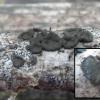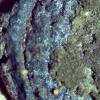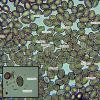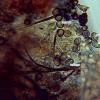
21-12-2025 21:32
Pol DebaenstHello, Garden, Burgweg 19, Veurne, BelgiumOn 10/1

21-12-2025 21:40
Isabelle CharissouBonjour, j'aimerais connaitre les références de

21-12-2025 21:31
Pol DebaenstHello, Garden, Burgweg 19, Veurne, BelgiumOn 10/1

21-12-2025 21:31
Pol DebaenstHello, Garden, Burgweg 19, Veurne, BelgiumOn 10/1

20-12-2025 23:08
Patrice TANCHAUDBonsoir, récolte sur sol sablonneux dans l'arri�

21-12-2025 09:32
Hello.A tiny ascomycete found embedded in wood in

20-12-2025 15:47
Mirek GrycHi.These grew on pine wood that was heavily covere
Unable to get even close to strange looking cup fungi on Corylus
Hardware Tony,
17-06-2020 21:54
 Not sure if anyone can help here, as rather unusual small fungus growing on a Corylus branch/twig found in litter of a damp, mossy woodland by a river. Each FB is well under 1cm. Spores are the best I can do, other than the macro appearance and tight fitting nature to the substrate. The excipulum appears blue/bck with the apothecia clearly olive green. The spores measure 6.80 - 7.62?m x 4.26 - 4.85µm, at 1000x are verrucose and also dark olive looking with a heavy thick wall. The whole body of the fungus was strongly gelatinous in the state found here and possibly has probasidial sac spore production, which I guess doesn't make this an ascomycete. It all suggests an asco then no asci/paras to be seen. Don't expect an immediate ID but maybe just a suggestion where I should look some more if not an asco.
Not sure if anyone can help here, as rather unusual small fungus growing on a Corylus branch/twig found in litter of a damp, mossy woodland by a river. Each FB is well under 1cm. Spores are the best I can do, other than the macro appearance and tight fitting nature to the substrate. The excipulum appears blue/bck with the apothecia clearly olive green. The spores measure 6.80 - 7.62?m x 4.26 - 4.85µm, at 1000x are verrucose and also dark olive looking with a heavy thick wall. The whole body of the fungus was strongly gelatinous in the state found here and possibly has probasidial sac spore production, which I guess doesn't make this an ascomycete. It all suggests an asco then no asci/paras to be seen. Don't expect an immediate ID but maybe just a suggestion where I should look some more if not an asco.Looked at Bulgariella pulla but no match.
With many thanks
Tony Hardware
Charles Aron,
17-06-2020 22:21

Re : Unable to get even close to strange looking cup fungi on Corylus
Hi Tony,
I think this might be a dessicated Exidia that has become overgrown with an olive-green hyphomycete.
Kind regards,
Charles.
Alain GARDIENNET,
18-06-2020 10:54
Re : Unable to get even close to strange looking cup fungi on Corylus
Hi ,
It reminds me more Hadrotrichum pyrenaicum, anamorph of Hypoxylon cercidicolum, growing on Fraxinus.
Alain
Hardware Tony,
18-06-2020 15:18

Re : Unable to get even close to strange looking cup fungi on Corylus
Hi Alain/Charles,
Alain your suggestion seems spot on to me just from a macro point of view. The Hypoxylon is quite unusual in the way is sits on the substrate and nothing I can find matches this elsewhere. The spores are correct for the conidia state for Hadrotrichum pyrenaicum. Found on a twig on the woodland floor in dark damp mostly Corylus trees. Obviously there is a Fraxinus among these I didn't see. You probably have helped identify a 1st for the UK, with grateful thanks. No records on British Mycol. Soc and one possible record from Scotland earlier this year. That cited the mature state, but probably was H. pyrenaicum if a genuine record.
Added one more image found showing the cross-section of the structure producing perithecia.
So grateful thanks to you and to AscoFrance.
Tony
Alain your suggestion seems spot on to me just from a macro point of view. The Hypoxylon is quite unusual in the way is sits on the substrate and nothing I can find matches this elsewhere. The spores are correct for the conidia state for Hadrotrichum pyrenaicum. Found on a twig on the woodland floor in dark damp mostly Corylus trees. Obviously there is a Fraxinus among these I didn't see. You probably have helped identify a 1st for the UK, with grateful thanks. No records on British Mycol. Soc and one possible record from Scotland earlier this year. That cited the mature state, but probably was H. pyrenaicum if a genuine record.
Added one more image found showing the cross-section of the structure producing perithecia.
So grateful thanks to you and to AscoFrance.
Tony
Peter Thompson,
18-06-2020 22:46
Re : Unable to get even close to strange looking cup fungi on Corylus
Hello Tony,
This is species 506 in my book. There are 27 records in CATE2, mainly from southern England, but not Cornwall. 14 of these are Ainsworth's records, so they should be in the BMS database too.
The conidial state and sexual state of a fungus count as one species, for any where the relationship has been scientifically proven.
One very common example is the ascomycete Rhytisma acerinum, for which the conidial state Melasmia acerina is much more frequently found throughout the year.
With Best Wishes,
Peter.
This is species 506 in my book. There are 27 records in CATE2, mainly from southern England, but not Cornwall. 14 of these are Ainsworth's records, so they should be in the BMS database too.
The conidial state and sexual state of a fungus count as one species, for any where the relationship has been scientifically proven.
One very common example is the ascomycete Rhytisma acerinum, for which the conidial state Melasmia acerina is much more frequently found throughout the year.
With Best Wishes,
Peter.
Hardware Tony,
19-06-2020 20:23

Re : Unable to get even close to strange looking cup fungi on Corylus
Many thanks Peter, I was seraching in BMS for ....dicolum, not .....dicola as now informed. 23 records there. I was even more confused when checking CATE2 yeserday when searching I got a single result only from Scotland. Did it again tonight as you said and 27 pop up. Still nice to see it's a first for the Sth West and still a nice find. So sorry Alain if I elevated you too quickly but you must be worth it anyway otherwise I would never have got to this species until I had your lead!
Tony
Tony







